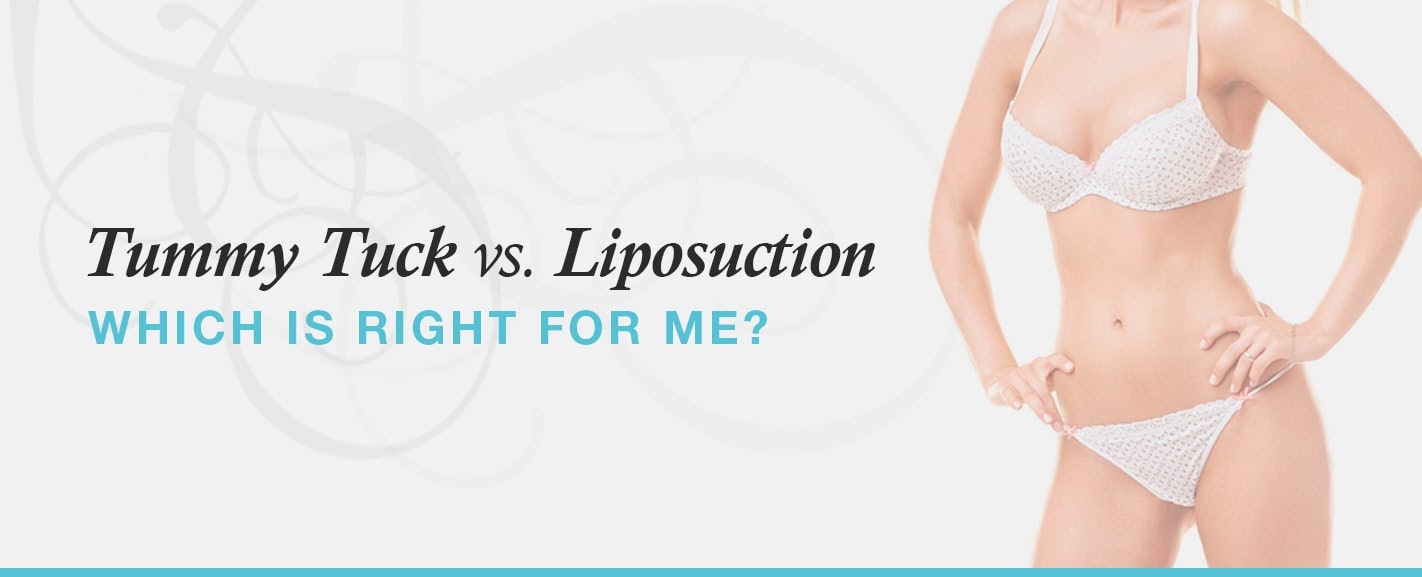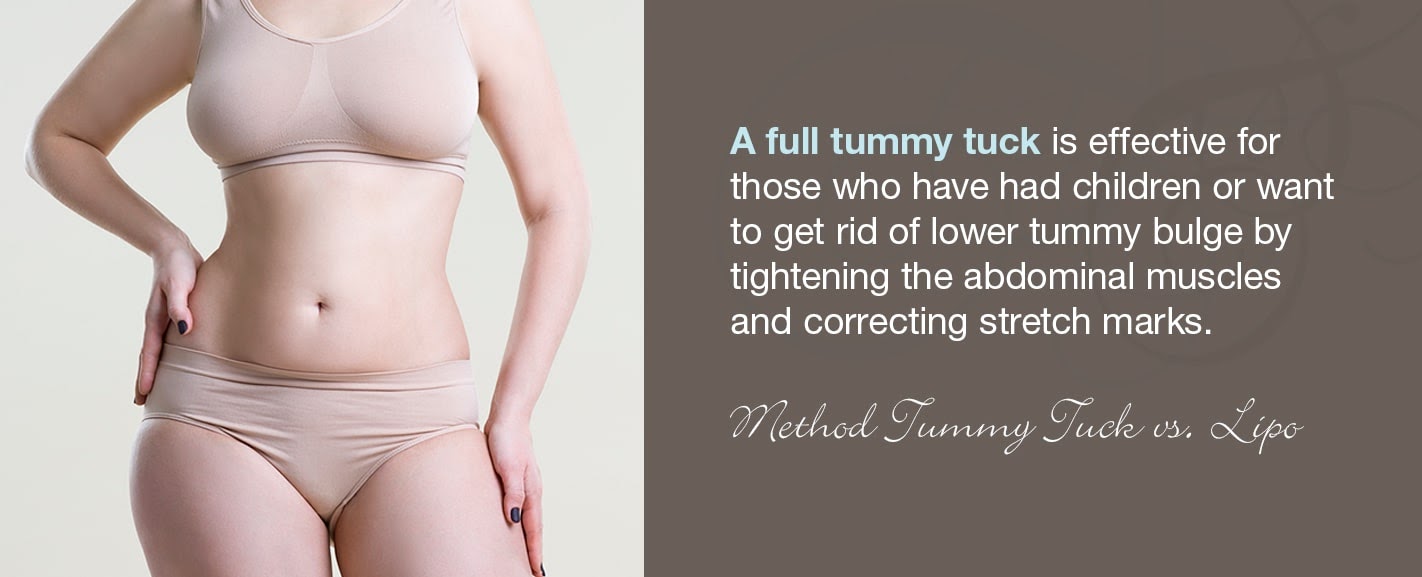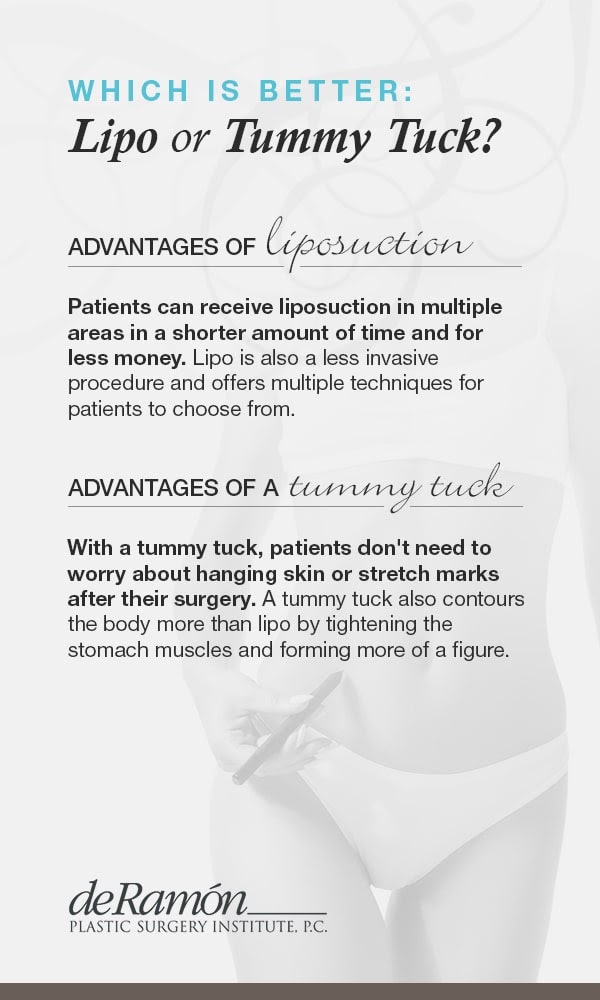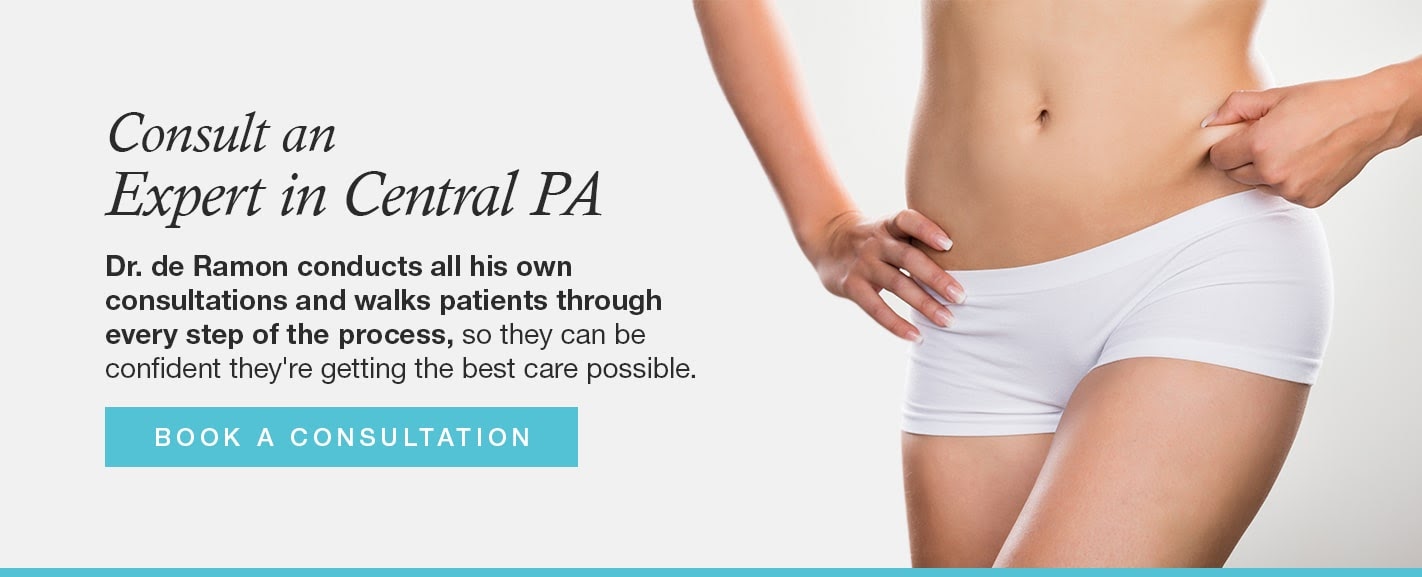Tummy Tuck vs. Liposuction: Which Is Right for Me?

When considering abdominal plastic surgery, the first question is usually whether the patient should get a tummy tuck or liposuction. This is a fair question, considering they are the two most popular abdominal-contouring procedures. In fact, liposuction is the second most common cosmetic surgery in the country, with 211,067 procedures per year.
Both tummy tucks and liposuction can be used to give patients the slim, toned stomach they’ve always wanted, but the techniques they use are slightly different. A patient’s personal anatomy, lifestyle and goals will determine which of the procedures is right for them.
For those wondering how to choose between a tummy tuck and liposuction, this article will help them weigh the options by discussing the similarities and differences between a tummy tuck and lipo, the benefits and drawbacks of each, who is a candidate for a tummy tuck and who is a candidate for liposuction and whether the procedures can be combined.
Tummy Tuck vs. Lipo
Although commonly confused or used interchangeably, the terms tummy tuck and liposuction refer to two distinct procedures. Before making any surgical decisions, it is important for patients to look at what the differences are between liposuction and a tummy tuck, so they undergo the procedure that’s right for them.
Here are the key differences to recognize when thinking about a tummy tuck or liposuction:
Purpose of a Tummy Tuck vs. Lipo
Both tummy tucks and liposuction are invasive plastic surgery procedures used to reduce excess fat. As the name suggests, a tummy tuck is intended to get rid of unwanted fat in the abdominal region. The surgery is purely cosmetic and used to make the patient’s stomach thinner and firmer while trimming away excess skin to prevent sagging.
On the other hand, liposuction can be used to remove fat in multiple areas of the body, including the stomach, buttocks, legs, chest, back, upper arms, hips and even chin. Lipo can help patients target areas with excess fat and sculpt the body more than natural weight loss, which sometimes results in a misshapen or uneven look.
Deciding between liposuction and a tummy tuck procedure will depend on your personal goals; ultimately, a tummy tuck is more invasive but will also address excess skin as where liposuction is a less invasive procedure but only focuses on fat in the body. Dr de Ramon can help you decide which is right for you based on your body goals when you schedule a consultation.
Method
During liposuction, the surgeon uses a cannula, a thin tube, connected to a suction system that literally suctions the fat out of the patient’s body. In this way, liposuction empties an area of fat, but the skin doesn’t tighten after lipo. Although lipo always involves using a cannula to remove excess fat, there are different techniques used to make the fat easier to suction.
These are the three main types of liposuction:
- Tumescent: Before surgery, the target area is injected with a sterile solution of saline, lidocaine and epinephrine to make suctioning the fat easier with less pain and blood loss. This is the most common method of liposuction.
- Ultrasound-assisted: This technique liquefies fat by using the energy of ultrasonic vibrations under the patient’s skin to rupture the fat’s cell walls. The liquified fat is then suctioned out.
- Laser-assisted: This type of lipo also liquefies the fat before suctioning it out, but instead of sound waves, a laser is used to generate a burst of energy that liquefies the fat. Typically, laser-assisted liposuction is best for smaller areas like the chin.
Because a tummy tuck takes care of excess skin along with fat, it is a more invasive procedure than liposuction. A full tummy tuck tightens the abdominal area by applying sutures to the connective tissue within the stomach and repairing muscle. This more in-depth technique is effective for those who have had children or want to get rid of lower tummy bulge by tightening the abdominal muscles and excising stretch marks.
Tummy Tuck vs. Lipo: Surgery Details
Patients can schedule a tummy tuck or liposuction at a hospital or an outpatient surgical facility. Typically, neither of the procedures requires an overnight stay, and patients may go home the same day unless they undergo a more extensive version of the procedure. Once again, tummy tuck and liposuction procedures are very similar but feature some slight differences.
Here is what to expect from a tummy tuck:
- Initial visits: A tummy tuck should only be scheduled after both a consultation and a pre-op appointment to discuss details of the procedure, what to expect, obtain consent and complete the necessary paperwork and prescriptions.
- Preparation: In the time leading up to surgery, a tummy tuck patient should continue to take their prescriptions or adjust current medications as needed, avoid anti-inflammatory drugs that can increase bleeding and quit smoking.
- Day of surgery: Upon arrival at the surgery center, the patient’s abdomen gets marked for the procedure and any final questions are answered.
- Anesthesia: General anesthesia is used during tummy tucks, meaning the patient will be completely unconscious and unable to feel pain.
- Procedure: Incisions are made around the belly button and at the bikini line, and excess fat and hanging skin are removed. After the abdominal muscles underneath have been tightened with sutures, the belly button is then sutured back into its normal place. In some cases, drains are put along the incision site to clear away any excess blood or fluid.
- Total duration: The entire procedure takes about three hours.
- Leaving: A family member or friend should give the tummy tuck patient a ride home.
This is what to expect from liposuction:
- Initial visits: Liposuction follows a consultation and pre-op appointment, which clarifies the area the patient is getting lipo on, logistics of the procedure and any necessary prescriptions or paperwork.
- Preparation: The patient should follow the same steps as a tummy tuck patient — take essential medications, stop smoking and avoid anti-inflammatories.
- Day of surgery: Upon arrival at the office or surgery center, the patient is marked for incision sites and contour areas.
- Anesthesia: Depending on what part of the body the patient is receiving lipo on, they will receive either general anesthesia or local anesthesia, which numbs the pain but leaves patients awake.
- Procedure: Small incisions in the skin are made in the spot getting liposuction, and a cannula is inserted into the fat pocket to extract the excess fat. Built-up blood or fluid is removed by small drainage tubes.
- Total duration: Liposuction usually takes a few hours. Timing varies depending on the size of the area being treated.
- Leaving: The patient should have someone with them to drive them home after their liposuction procedure.
Cost of a Tummy Tuck vs. Liposuction
Because liposuction is a less invasive and shorter procedure, it typically costs less than a tummy tuck. The exact price of a tummy tuck or liposuction varies, depending on the area getting treated, the amount of fat being removed and the doctor’s pricing. Medical insurance does not cover cosmetic surgeries like a tummy tuck or liposuction.
Recovery
Immediately after both liposuction and a tummy tuck, a compression garment is placed on the patient to support the affected area. Patients will need to continue to wear the compression garment for about one to two months after the surgery. Bruising, swelling and soreness are all normal, but the compression garment should help to minimize any discomfort.
Tummy tuck and lipo patients typically see their doctors a few days after the procedure to check in on the treated area for any unusual bleeding or other complications. Post-operation pain should not be severe for either of the procedures and may be controlled with prescription pain medications or Tylenol.
There are a few key differences between liposuction and tummy tuck recovery:
What Is Liposuction Recovery Like?
For liposuction patients, the recovery process will most likely be shorter and easier than for tummy tuck patients. Within a week of liposuction surgery, the patient’s stitches will be removed at a post-op appointment. After lipo, patients should wait 5-7 days before returning to most normal activities, but most should be fully healed in about two weeks.
What Is Tummy Tuck Recovery Like?
Tummy tuck patients will have a longer recovery process due to the more intensive nature of their surgery. Most tummy tuck patients should ask off of work for about seven to ten days, and take about six weeks to begin any sort of exercise again. Recovery will look a bit different for every patient, depending on their personal anatomy and medical history.
The biggest difference between the tummy tuck and liposuction recovery process is scar care. A tummy tuck incision is usually larger than a lipo incision, meaning a tummy tuck scar will need much more attention to heal properly. Tummy tuck scar care commonly consists of taping the incision for about a month, followed by applying scar cream for another 2-3 months, allowing the scar to thin and fade over time.
Follow-Ups
As with any surgery, tummy tucks and liposuction come with risks. Infection, complications from anesthesia and excessive bleeding or blood clotting are possible results of both procedures. Although these are risk factors for any surgical procedure, there are some more specific to tummy tucks and liposuction.
These are some of the potential complications for each operation:
- Liposuction: Fluid accumulation, reactions to lidocaine, numbness, uneven fat removal, nerve damage and a fat embolism blocking blood flow.
- Tummy Tuck: Fluid accumulation, tissue damage, numbness, poor wound healing and excessive scarring.
It’s important that patients maintain their follow-up appointment schedules, so any negative side effects may be avoided or addressed as soon as possible.
Tummy tuck patients will require more check-ups than lipo patients to make sure their recovery process is going smoothly. Typically, tummy tuck patients will see their doctor a few days after their procedure and then schedule regular follow-up appointments, depending on the doctor’s standard tummy tuck timeline. On the other hand, many lipo patients usually need only one post-surgery visit, but each lipo patient should still ask their doctor whether they’ll need multiple follow-ups.
Results
For both liposuction and tummy tucks, the best results will be seen after the healing process is complete, which will be after about three months. Three months is enough time for the swelling and scarring to reduce, leaving a leaner figure. After the swelling has gone down, the patient’s doctor will take their “after” picture to highlight their body’s changes and celebrate their results.
A tummy tuck is intended to have long term results, considering the internal sutures set in place to repair the abdominal muscles are not designed to ever need removing. As long as the patient maintains a stable weight, the tummy tuck results will remain. Lipo patients will also be able to enjoy long term results as long as they manage their weight well.
Which Is Better: Lipo or Tummy Tuck?
Unfortunately, there is no straight answer to the question, “is a tummy tuck better than liposuction?” Each patient has different needs and reasons for wanting the procedure, so comparing a tummy tuck and lipo is not that simple. When considering the two procedures, it’s important to take all of their advantages and disadvantages into account.
These are the main benefits and drawbacks of each option:
Advantages of Liposuction
As discussed, lipo does not require the same amount of recovery time as a tummy tuck. Instead, patients can receive liposuction in multiple areas in a shorter amount of time and for less money. Lipo is also a less invasive procedure and offers multiple techniques for patients to choose from.
Disadvantages of Liposuction
Skin does not tighten after lipo, which means certain areas could still be saggy. Lipo could also result in uneven fat removal, creating a more misshapen look or jagged impression across the top layer of skin.
Advantages of a Tummy Tuck
A tummy tuck’s main advantages are repair of the abdominal wall muscle and excess skin removal. With a tummy tuck, patients don’t need to worry about hanging skin or stretch marks after their surgery. A tummy tuck also contours the body more than lipo by tightening the stomach muscles and forming more of an hourglass figure.
Disadvantages of a Tummy Tuck
A tummy tuck only gets its great results by being a more invasive procedure. Greater caution comes with more intensive operations, so a tummy tuck requires patients to be more attentive to scar care. Because of its long recovery period and more post-op appointments, a tummy tuck costs patients both more time and more money than liposuction.
Should I Get a Tummy Tuck or Liposuction?
Based on the benefits and drawbacks of each procedure, a tummy tuck is the better option for anyone who has loose skin from significant changes in weight, pregnancy or abdominal surgery, like a C-section. Liposuction might be preferred if the patient doesn’t struggle with stretch marks and is looking for a less expensive, less invasive surgery with minimal recovery, yet satisfying results.
Regardless of whether the patient chooses a tummy tuck or liposuction, both procedures remove the fat cells permanently, which means the results are long-lasting as long as a healthy diet and regular exercise are maintained.
Do I Need a Tummy Tuck and Liposuction?
Does a tummy tuck require liposuction? No, but when considering the potential benefits of each procedure, some patients may want to think about combining them. Liposuction can be paired with a tummy tuck to reduce excess fat and refine the stomach area’s shape and skin.
Adding a tummy tuck is often an effective way to avoid the uneven fat removal that sometimes comes with lipo. So, do you need a tummy tuck and liposuction? The answer could be yes. Whether the liposuction or tummy tuck comes first depends on a patient’s particular needs and their doctor’s preferred method.
There are two ways to get the benefits of liposuction with a tummy tuck:
- Combo approach: Depending on the patient’s condition, the tummy tuck and lipo can be done within the same procedure.
- Staging: If a large volume of fat needs to be removed, each surgery will need to be staged separately to minimize bleeding and trauma. In some cases, staging multiple plastic surgery procedures is safer.
What Should I Ask My Doctor?
Patients should consult with their doctor before making a final decision about lipo or a tummy tuck. When visiting the doctor, patients should ask if they need a tummy tuck or liposuction, as well as whether they have any pre-existing conditions or illnesses that would inhibit them from getting either of the procedures. The doctor will be able to look at their health history and recommend what’s best for them, whether it be lipo, a tummy tuck, both or neither.
Consult an Expert in Central PA
The most important step in any liposuction or tummy tuck decision is finding a trusted doctor. For those looking for a cosmetic surgery expert in the Central PA area, contact de Ramon Plastic Surgery Institute, P.C. Dr. de Ramon is certified by the American Board of Plastic Surgery and dedicated to delivering natural-looking results.
He is experienced in both tummy tuck and liposuction procedures and is able to help patients figure out which technique is right for them. Dr. de Ramon conducts all his own consultations and walks patients through every step of the process, so they can be confident they’re getting the best care possible.
Call 717-798-8573 to book a consultation today.





